Craving that rich, melty, golden-crusted chicken dish without the mess of frying? This guide to baked chicken parmesan gives you all the tools to master a healthier, easier version of the Italian-American classic—without sacrificing flavor or crispiness. You’ll learn how to achieve restaurant-quality results using simple ingredients and oven-baking methods. Whether you’re a seasoned home cook or just starting out, this is your go-to resource for creating crispy chicken parmesan in your own kitchen.
Looking for inspiration? Try our Easy Chicken Cheesesteak Skillet for another weeknight dinner win.
Let’s start by understanding what makes this dish so timeless.
Table Of Content
Table of Contents
What Is Baked Chicken Parmesan?
The Origins of Chicken Parmesan and Parmigiana
Baked chicken parmesan—or simply “chicken parm”—is a beloved fusion of Italian and American cooking traditions. It evolved from eggplant parmigiana, a southern Italian dish, where tender eggplant slices are breaded, fried, and layered with marinara and cheese. In the U.S., cooks swapped in chicken cutlets and baked them to crispy perfection, creating what we now enjoy as baked chicken parmesan.
The name “parmigiana” refers to the preparation style rather than the cheese. Both terms, chicken Parmesan and chicken parmigiana, are used interchangeably, though “Parmesan” has become more common in American kitchens. What truly sets the dish apart is its mix of bold tomato sauce, bubbling cheese, and golden-baked crust.
What Makes Baked Chicken Parmesan Unique vs. Fried Versions
Unlike its fried counterpart, baked chicken parmesan is cooked in the oven, skipping the oil without losing the crunch. The breading is made with a mix of panko breadcrumbs and grated Parmesan, then baked until it’s golden and crisp.
Why choose baking over frying?
| Fried Chicken Parmesan | Baked Chicken Parmesan |
|---|---|
| More oil, higher fat content | Lower calorie, healthier |
| Messy to prepare on stovetop | Easy sheet pan method |
| Often greasy | Light and crispy |
| Shorter shelf-life when stored | Stays crisp even after reheating |
With baked chicken parmesan, you’re keeping all the comfort food flavors you love while ditching the grease. This healthier twist makes it ideal for family dinners, meal prepping, or entertaining guests.
Check out the comforting BBQ Beef Sandwich for another crave-worthy recipe.
Ingredients for the Perfect Baked Chicken Parmesan
Essential Ingredients Breakdown (Cheese, Chicken, Coating)
When making baked chicken parmesan, the secret to big flavor lies in using quality ingredients. Each component contributes to the crispy, cheesy goodness that makes this dish so satisfying. Let’s break it down:
1. Chicken Cutlets
Boneless, skinless chicken breasts are your best bet. Slice them in half lengthwise or pound them thin for even cooking. Thin cutlets cook faster and absorb the coating better, ensuring a crispy exterior and juicy interior.
2. Breadcrumbs
Use panko breadcrumbs instead of regular ones. They’re lighter, crispier, and perfect for oven-baking. To boost flavor, mix them with Italian seasoning and garlic powder.
3. Parmesan Cheese
This recipe isn’t complete without freshly grated Parmesan. It adds sharp, nutty flavor and helps create a golden crust when baked. Always avoid the pre-packaged kind in the shaker—it lacks the texture and richness needed.
4. Mozzarella Cheese
Use whole milk mozzarella for the best melt and stretch. Pre-shredded cheese is fine in a pinch, but freshly shredded blocks yield better results.
5. Eggs
A couple of beaten eggs help the breadcrumb mixture stick to the chicken, creating that essential crispy coating.
6. All-Purpose Flour
Before dipping chicken into eggs and breadcrumbs, a light coating of flour helps bind everything together and adds another layer of crispiness.
7. Olive Oil Spray
Instead of frying, we use a quick spritz of olive oil on both sides of the breaded chicken before baking. This helps create that crispy, golden finish in the oven.
8. Marinara Sauce
Choose a robust, garlicky homemade marinara or a high-quality store-bought version. We’ll dive deeper into sauce choices in Part 6, but a rich tomato flavor is key here.
Discover great ideas like the French Stuffed Cabbage Rolls (Choux Farcis) if you’re in the mood for another comforting main dish.
Best Herbs and Spices to Elevate the Flavor
Here are the flavor boosters that will elevate your baked chicken parmesan beyond basic:
- Italian seasoning: A must-have blend of basil, oregano, rosemary, and thyme.
- Garlic powder: For that warm, savory base.
- Crushed red pepper flakes: Adds a mild kick without overpowering.
- Fresh basil or parsley: Garnish right before serving for a fresh pop of color and flavor.
- Salt & black pepper: Keep it simple but essential for seasoning the chicken and breadcrumbs.
Want a quick checklist for shopping or meal prep? Here’s a visual table for convenience:
| Ingredient | Purpose | Tips |
|---|---|---|
| Chicken breasts | Main protein | Pound thin for even cooking |
| Panko breadcrumbs | Crispy outer layer | Combine with herbs and Parmesan |
| Parmesan cheese | Flavor & texture in coating | Use freshly grated only |
| Mozzarella | Melty cheesy topping | Whole milk version preferred |
| Eggs | Helps coating stick | Beat lightly |
| Flour | First coating layer | Light dusting before eggs |
| Olive oil spray | Crispy finish when baking | Spray both sides before oven |
| Marinara sauce | Moisture & flavor | Use rich tomato-based sauce |
With just a few staple ingredients, you can transform your kitchen into an Italian trattoria—no frying required.
Step-by-Step Instructions to Make Baked Chicken Parmesan
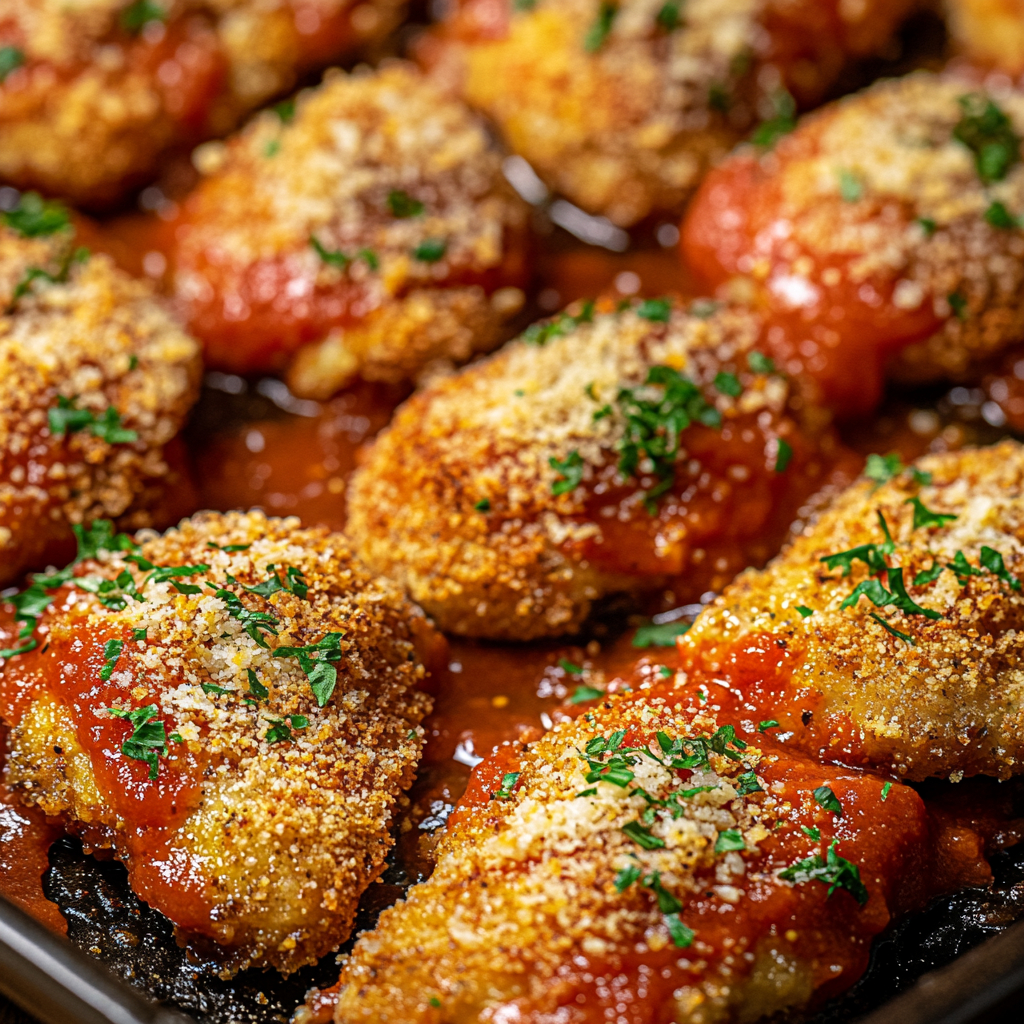
How to Properly Bread Chicken Cutlets
The foundation of crispy baked chicken parmesan is perfectly breaded cutlets. Here’s how to do it right:
Step 1: Prep the Chicken
Start by slicing large chicken breasts in half horizontally to create thin cutlets. Use a meat mallet to pound them evenly—this ensures they bake uniformly and stay juicy.
Step 2: Set Up a Breading Station
Use three shallow dishes:
- Dish 1: All-purpose flour seasoned with salt and pepper.
- Dish 2: Lightly beaten eggs.
- Dish 3: A mixture of panko breadcrumbs, grated Parmesan, garlic powder, and Italian seasoning.
Step 3: Dredge the Cutlets
Coat each chicken cutlet in flour, shaking off the excess. Next, dip it into the egg wash, and then press it firmly into the breadcrumb mixture until fully coated.
Step 4: Rest the Breaded Chicken
Let the breaded chicken sit on a baking rack or tray for 10 minutes before baking. This helps the coating stick and reduces sogginess in the oven.
Tips for Baking Instead of Frying Without Losing Crispiness
You don’t need a fryer to get crispy, golden perfection. Follow these baking tips for the ultimate baked chicken parmesan experience:
Use a Wire Rack
Place the chicken on a wire rack over a baking sheet. This allows hot air to circulate around the chicken, crisping the bottom and preventing sogginess.
Preheat the Oven to 400°F
A hot oven is key. Baking at 400°F allows the breading to crisp while locking in the moisture. For extra crunch, bake for 18–20 minutes or until the internal temperature reaches 165°F.
Spray with Olive Oil
Lightly spray the tops of the breaded chicken with olive oil or cooking spray before baking. This encourages browning and mimics the crispy effect of frying.
Add Cheese and Sauce at the End
After the initial bake, remove the chicken and top each piece with marinara sauce and mozzarella. Return to the oven for an additional 5–7 minutes, just until the cheese melts and bubbles.
Optional: Broil for 2 Minutes
Want that irresistible golden cheese top? Switch the oven to broil for the last 2 minutes. Watch it closely to avoid burning.
Here’s a quick timeline to guide you:
| Step | Time | Notes |
|---|---|---|
| Bread chicken | 10 minutes | Allow to rest after breading |
| Bake at 400°F | 18–20 mins | Until internal temp hits 165°F |
| Add sauce & cheese | 5–7 minutes | Until cheese melts and bubbles |
| Optional broil | 2 minutes | For extra golden cheese |
With this simple, no-fry process, you’ll get crispy edges, juicy centers, and all the comfort of traditional chicken parm—made healthier and faster.
Don’t miss our Healthier Cheesy Hashbrown Casserole for another smart comfort food swap (this is a placeholder for an orphan link suggestion).
Baking Temperature Tips for Perfect Results
Should You Bake Chicken at 350 or 400?
When it comes to baking chicken, the temperature matters more than you might think—especially if you’re after that perfect crispy crust and juicy center in your baked chicken parmesan.
The common debate is whether to bake at 350°F or 400°F. Here’s the truth: 400°F is the sweet spot for this dish.
Why 400°F Works Best:
- Crispier Crust: Higher heat helps activate the oils in the breadcrumbs and Parmesan, giving you that crunchy golden layer without frying.
- Faster Cooking: Thinner cutlets cook quickly, and 400°F ensures the chicken reaches the safe internal temp of 165°F without drying out.
- Perfect Cheese Melt: At 400°F, your mozzarella gets bubbly and browned just enough without overcooking the chicken underneath.
While baking at 350°F is still safe, it tends to produce softer breading and can result in slightly drier chicken if not watched carefully. If you’re using thicker cuts or want a slower bake for another dish, 350°F might be appropriate—but for baked chicken parmesan, 400°F is ideal.
Pro Tip: Always preheat your oven. Starting with a hot oven helps lock in moisture and starts crisping the coating right away.
How Baking Time Affects Texture and Flavor
Baking time is just as important as the temperature. Overbaking dries out the chicken and underbaking leaves you with soggy breading—and unsafe meat. Here’s how to get it just right:
General Guidelines:
| Cutlet Thickness | Bake Time at 400°F | Notes |
|---|---|---|
| 1/2 inch or less | 15–18 minutes | Thin cutlets, check early |
| 3/4 inch | 18–20 minutes | Most common for chicken breasts |
| 1 inch or more | 22–25 minutes | Consider slicing or pounding |
Use a meat thermometer to check that the thickest part of the chicken reaches 165°F—this is the USDA-recommended safe temperature for poultry.
Flavor Tip: Add sauce and cheese only during the final 5–7 minutes of baking. This keeps the breading crispy and prevents the cheese from overcooking.
Optional Finishing Touch: After the full baking time, broil the chicken for 1–2 minutes. This gives you golden cheese tops and slightly caramelized marinara for a gourmet look and taste.
Want a comfort food twist that bakes beautifully like this one?
Don’t miss our French Crepes Guide for another fun, oven-friendly recipe (another dynamic orphan link suggestion).
How to Get Crispy Baked Chicken Parmesan Every Time
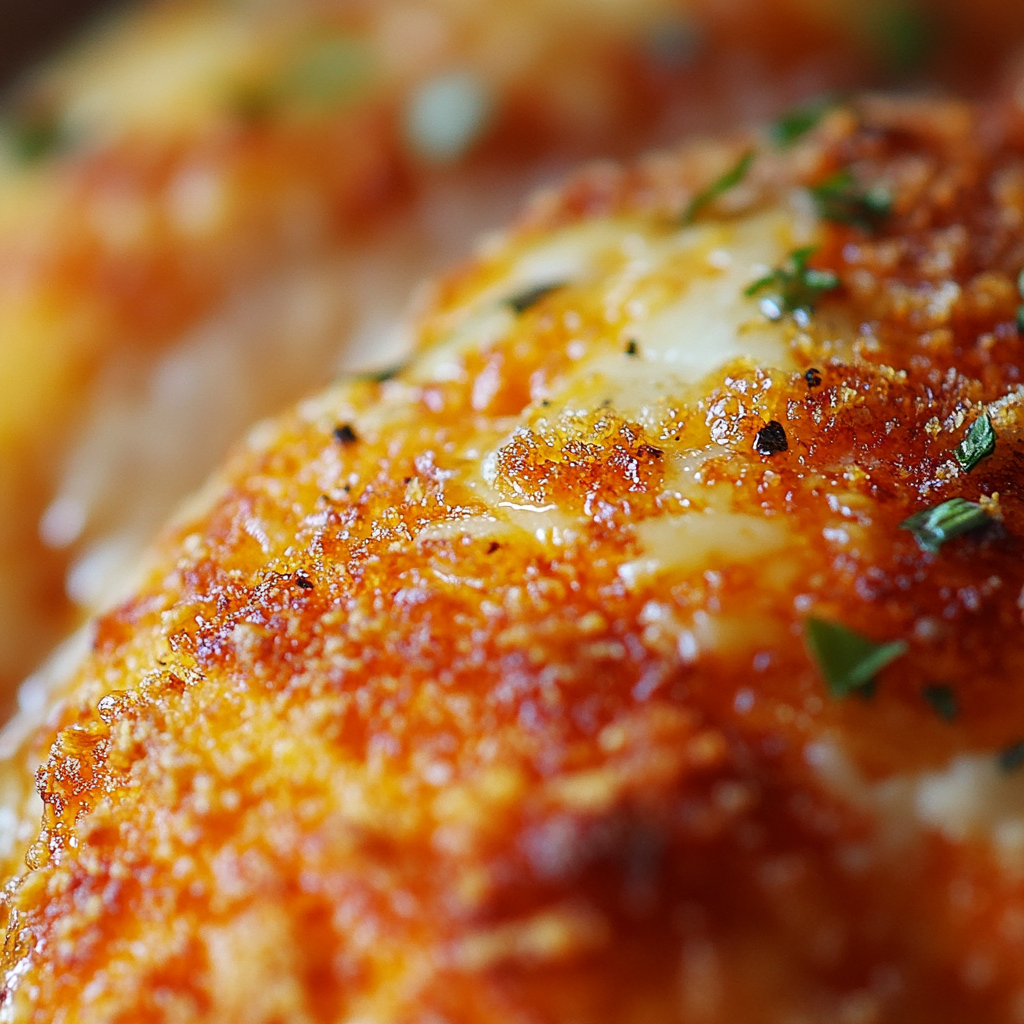
If there’s one thing everyone craves in a great baked chicken parmesan, it’s that golden crunch. Getting that signature crispy outer layer without deep frying may seem tricky, but with the right method, you’ll master it like a pro. Here’s how to create the ultimate crispy baked chicken parmesan every single time.
Tips for a Golden, Crispy Coating Without Frying
Don’t settle for soggy. Use these proven methods to crisp things up:
1. Use Panko, Not Regular Breadcrumbs
Panko breadcrumbs are light, flaky, and perfect for oven-baking. They create that signature crunchy bite we love in a well-made baked chicken parmesan.
2. Toast the Breadcrumbs First
Want a head start on crispiness? Toast the breadcrumb-Parmesan mixture in a 350°F oven for 5 minutes before coating the chicken. This pre-bakes the crunch right in.
3. Elevate with a Wire Rack
A wire rack allows air to circulate under the chicken, so every side stays crispy. Place it on a baking sheet, and skip flipping—this keeps your breading intact.
4. Olive Oil Spray Is a Must
Lightly spray the coated chicken with olive oil. It helps the breadcrumbs brown evenly and gives your baked chicken parmesan that classic fried look—without the oil.
5. Add Sauce at the Right Time
Timing matters. Add marinara just before the final bake to prevent the sauce from soaking through the crust. A couple of spoonfuls per piece is plenty.
The Secret Role of Panko, Parmesan, and Oven Temperature
Let’s break down this crispy trinity that transforms basic into brilliant:
| Ingredient | Why It Works | How to Use |
|---|---|---|
| Panko | Extra airy, stays crispy when baked | Mix with Parmesan and herbs |
| Parmesan | Melts into the breadcrumbs for texture | Grate fresh for best results |
| 400°F Oven | High enough to crisp without overcooking | Bake 18–20 mins, then broil |
Finish Strong: After baking, broil your baked chicken parmesan for 1–2 minutes. This melts and slightly browns the cheese, giving you that gooey top with a golden edge.
You don’t need oil splatter or frying pans to get crunch. These techniques ensure your baked chicken parmesan delivers the same satisfying texture—while being lighter, cleaner, and easier to make.
Check out our guide to the Easy Chicken Cheesesteak Skillet for another texture-packed, weeknight-friendly recipe.
PART 6: Sauce and Cheese for Authentic Chicken Parm
When it comes to flavor and texture, the sauce and cheese combo is what transforms basic baked chicken into indulgent baked chicken parmesan. This section will walk you through exactly what to use—and how to use it—to get that perfect, melty, saucy result every time.
What Kind of Sauce Goes on Chicken Parm?
The best sauce for baked chicken parmesan is a classic marinara sauce—rich in tomato flavor, seasoned with garlic, basil, and oregano. The sauce adds tang, moisture, and depth, balancing the crispy chicken and creamy cheese.
Here’s what to look for or create in a good marinara:
- Crushed San Marzano tomatoes: For sweetness and authentic Italian flavor.
- Fresh garlic & onion: Sautéed in olive oil for a fragrant base.
- Dried oregano & fresh basil: Classic Italian herbs to elevate the profile.
- Red pepper flakes (optional): A pinch adds just enough heat without overpowering.
You can use homemade marinara for maximum freshness, but a quality store-bought version works in a pinch. Just check the label—avoid sauces loaded with sugar or preservatives.
Pro Tip: Warm your sauce before spooning it over the chicken. Cold sauce can slow down the baking process and cause sogginess in the crust.
Choosing the Best Cheese Combinations for a Melty Finish
No baked chicken parmesan is complete without cheese—and lots of it. But which cheese is best? Here’s your guide:
1. Mozzarella
This is your melty MVP. Use whole milk mozzarella for the richest stretch and flavor. Avoid pre-shredded cheese if possible—it contains anti-caking agents that can affect texture.
2. Parmesan
Add freshly grated Parmesan to your breadcrumb coating and on top of the cheese layer. It sharpens the flavor and helps with browning.
3. Provolone or Fontina (Optional)
If you want to mix it up, provolone or fontina can be layered in with mozzarella for added creaminess and depth.
| Cheese | Purpose | Best Form |
|---|---|---|
| Mozzarella | Melty, creamy topping | Whole milk block |
| Parmesan | Sharp, nutty flavor | Freshly grated |
| Provolone | Mild and melty (optional blend) | Thin-sliced |
| Fontina | Adds buttery richness (optional) | Shredded or slices |
Layer Like a Pro: After your chicken bakes for 18–20 minutes, add a spoonful of marinara and a layer of cheese. Return it to the oven for 5–7 minutes, or until everything is bubbly. Want that irresistible golden topping? Broil it for 1–2 minutes to finish strong.
Cheese, sauce, and a crispy base—now that’s the holy trinity of baked chicken parmesan.
Looking for something saucy but different? Don’t miss our BBQ Beef Sandwich—an unexpected take on comfort with bold flavor.
Serving Suggestions for Baked Chicken Parmesan
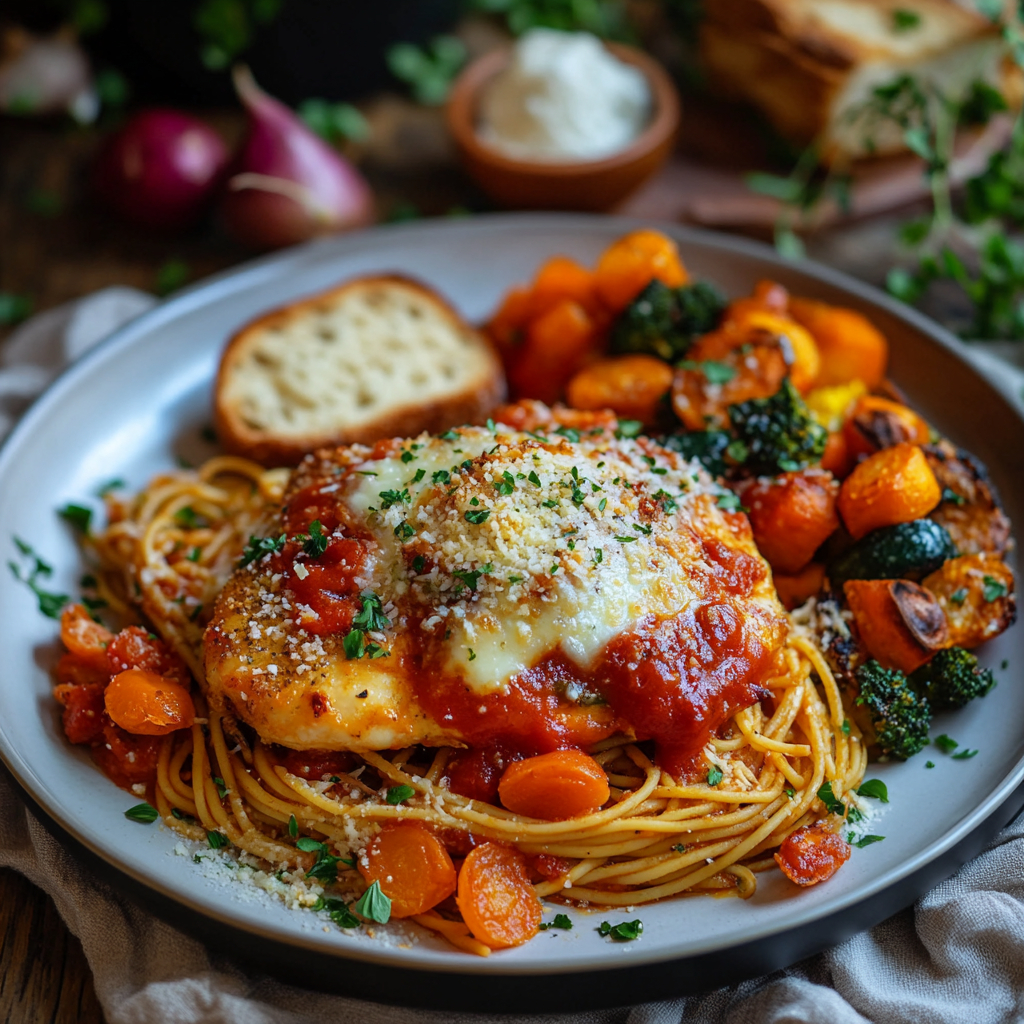
You’ve got a crispy, melty, flavor-packed baked chicken parmesan ready to go—now let’s talk about what to serve with it. Whether you’re feeding the family or planning a cozy dinner for two, these sides, sauces, and pairings complete the meal.
Best Pasta Pairings (Spaghetti, Linguine, etc.)
Chicken parm and pasta go together like Sunday and comfort food. But not all pasta shapes serve the same purpose. Here are some top choices:
1. Spaghetti
The traditional favorite. It holds marinara well and doesn’t overwhelm the plate. A simple buttered or garlic spaghetti is the perfect side.
2. Linguine
A touch flatter than spaghetti, it offers a little more surface area to grab onto that rich sauce. It’s also slightly more elegant for serving guests.
3. Angel Hair
This delicate pasta is great if you want a lighter pairing. Cook it al dente to prevent sogginess from the sauce.
4. Penne or Rigatoni
Prefer short pasta? These tube shapes work beautifully to trap bits of sauce and cheese. They’re especially good for baked versions.
| Pasta Type | Texture | Best Use Case |
|---|---|---|
| Spaghetti | Classic and versatile | Everyday dinner or meal prep |
| Linguine | Slightly wider | Elevated presentations |
| Angel Hair | Thin and delicate | Lighter side, quicker cook time |
| Penne | Hearty and chewy | Holds up to extra sauce and cheese |
Pro Tip: Toss pasta in a touch of olive oil or extra marinara before plating—this keeps it from clumping and adds flavor.
Low-Carb and Gluten-Free Side Dish Options
If you’re keeping things lighter or gluten-free, don’t worry—baked chicken parmesan still shines with these delicious sides:
1. Zucchini Noodles (Zoodles)
Spiralized zucchini tossed lightly in olive oil and garlic makes for a clean, crisp substitute to pasta.
2. Cauliflower Rice
Sauté it with garlic and Parmesan for a side that pairs well with marinara without weighing you down.
3. Roasted Veggies
Think bell peppers, asparagus, broccoli, or eggplant. Roast at 425°F with olive oil and Italian seasoning until caramelized.
4. Garden Salad
A fresh salad with a balsamic vinaigrette cuts through the richness of the cheese and sauce.
Want a lighter take on classic comfort food?
Discover our Healthier Cheesy Hashbrown Casserole for another guilt-free side (dynamic orphan link placement).
Whether you stick with spaghetti or go low-carb, the right pairing makes your baked chicken parmesan meal feel complete and crave-worthy.
PART 8: Common Mistakes to Avoid When Making Baked Chicken Parmesan
Even with a great recipe, a few small missteps can turn a beautiful baked chicken parmesan into a soggy, bland letdown. If you want crispy coating, juicy chicken, and perfectly melted cheese every time, steer clear of these common pitfalls.
Overbaking or Underbaking Your Chicken
This is easily the most frequent error. Chicken that’s undercooked is unsafe, while overcooked chicken becomes dry and rubbery.
How to Avoid It:
- Use thin chicken cutlets—either buy them pre-cut or slice and pound your own.
- Bake at 400°F for 18–20 minutes depending on thickness.
- Always use a meat thermometer. The internal temp should be 165°F at the thickest point.
Bonus Tip: Let your chicken rest 5 minutes before cutting or serving. This locks in juices.
Using the Wrong Breadcrumbs or Cheese
Not all breadcrumbs or cheese are created equal—and using the wrong ones can cost you texture and taste.
Avoid These:
- Plain breadcrumbs – too fine and they don’t crisp well.
- Shaker Parmesan – lacks the melt and flavor of fresh grated cheese.
- Pre-shredded mozzarella – contains additives that hinder melting.
Use These Instead:
- Panko breadcrumbs – light and airy for that crispy crust.
- Freshly grated Parmesan – for bold, nutty flavor.
- Whole milk mozzarella – for that irresistible melt and stretch.
Skipping the Resting Time After Breading
If you go straight from breading to baking, the coating may slide off during cooking. Always let your breaded chicken rest for at least 10 minutes before it hits the oven.
This helps the egg and breadcrumb mixture adhere properly—and gives you a uniform crust.
Too Much Sauce, Too Early
Yes, sauce is important—but if you load up too early, it soaks into the crust and ruins the crunch.
How to Fix It:
- Bake the breaded chicken first.
- Add marinara and cheese during the last 5–7 minutes.
- Broil for the final 1–2 minutes for golden cheese tops.
This keeps your baked chicken parmesan crisp and picture-perfect.
Avoiding these mistakes takes your dish from “meh” to magnificent. Follow the tips above and you’ll never have to settle for soggy or bland chicken parm again.
Want another foolproof dish?
Try our French Stuffed Cabbage Rolls (Choux Farcis)—it’s rich, savory, and just as comforting.
PART 9: Storage, Leftovers, and Meal Prep Tips
So you’ve mastered making baked chicken parmesan—but what happens when you’ve got leftovers, or you want to prep ahead for a busy week? The good news is this dish stores and reheats surprisingly well with the right techniques.
How to Store and Reheat Without Losing Crispiness
One of the biggest fears with leftovers is soggy breading. Here’s how to avoid that:
Storing in the Fridge
- Let the baked chicken parmesan cool completely before storing.
- Place pieces in an airtight container with a paper towel underneath to absorb moisture.
- Store for up to 4 days in the refrigerator.
Reheating in the Oven (Best Method)
- Preheat oven to 375°F.
- Place the chicken on a wire rack over a baking sheet.
- Bake for 10–12 minutes or until heated through.
- Optional: Broil for 1–2 minutes at the end to re-crisp the cheese and crust.
Avoid the microwave if possible—it softens the crust and can make the chicken rubbery.
Freezer Instructions and Meal Prep Strategies
Want to batch cook your baked chicken parmesan for future meals? Here’s how to freeze and reheat it like a pro.
Freezing Before Baking
- Bread the raw chicken as usual.
- Lay pieces flat on a baking sheet lined with parchment and freeze for 1 hour.
- Transfer to a freezer-safe bag or container.
- Freeze for up to 3 months.
- Bake directly from frozen at 400°F for 25–28 minutes, then add sauce and cheese.
Freezing After Baking
- Cool completely.
- Wrap individual portions tightly in foil or freezer wrap.
- Store in a freezer bag for up to 2 months.
- Reheat in a 375°F oven for 15–18 minutes.
Make-Ahead Tip
Prep the chicken, marinara, and cheese separately up to 2 days in advance. Store them in the fridge, and assemble just before baking. This gives you a fresh-from-the-oven feel without the last-minute hassle.
With these smart storage and prep tips, your baked chicken parmesan can be a weeknight go-to, a freezer-friendly staple, or even part of your Sunday meal prep.
Looking for more easy prep inspiration?
Don’t miss our Easy Chicken Cheesesteak Skillet—it’s another one-pan meal with minimal cleanup and major flavor.
FAQ: Baked Chicken Parmesan Questions Answered
Should you bake chicken at 350 or 400?
For baked chicken parmesan, baking at 400°F is the better option. It ensures a crispier crust and juicy interior. While 350°F can work, it often results in longer cook times and softer breading. A higher temperature helps the coating brown properly without drying out the meat.
Pro Tip: Always preheat your oven and use a meat thermometer to check that your chicken reaches an internal temperature of 165°F.
What is the difference between chicken Parmesan and chicken parmigiana?
There’s no real difference—chicken Parmesan and chicken parmigiana refer to the same dish. “Parmigiana” is the Italian term, while “Parmesan” is the Americanized version. Both involve breaded chicken cutlets, marinara sauce, and melted cheese. In the U.S., baked chicken parmesan is commonly used to describe the oven-baked, healthier twist on this classic.
How to get crispy chicken Parmesan?
To get crispy baked chicken parmesan without frying, follow these tips:
- Use panko breadcrumbs mixed with Parmesan.
- Place the breaded chicken on a wire rack.
- Spray with olive oil before baking.
- Bake at 400°F, not lower.
- Add sauce and cheese only during the final few minutes of baking.
- For extra crunch, broil for 1–2 minutes at the end.
These methods give you that golden-brown crust you expect from the traditional fried version—without the oil.
What kind of sauce goes on chicken parm?
The best sauce for baked chicken parmesan is a rich marinara sauce made from crushed tomatoes, garlic, onion, basil, and oregano. You can use homemade or high-quality jarred versions. Avoid sugary sauces and look for bold, tomato-forward flavor with natural ingredients.
Warm the sauce before adding it to the chicken to preserve the crispy coating underneath.
That wraps up the key questions most people have about making the perfect baked chicken parmesan.
Don’t miss our full recipe breakdown earlier in this article to master each step.
Conclusion: Why Baked Chicken Parmesan Is a Must-Have in Your Recipe Rotation
Whether you’re a seasoned cook or a kitchen newbie, baked chicken parmesan is one of those rare recipes that checks every box—comforting, crispy, cheesy, and surprisingly easy to make. By ditching the fryer and embracing your oven, you still get the bold flavor and texture you love, just with fewer calories and less mess.
From mastering the perfect breading to using just the right amount of sauce and cheese, each step in this guide helps you level up your homemade chicken parm game. Serve it over pasta, pair it with roasted veggies, or freeze it for later—it’s the versatile, crowd-pleasing meal you’ll return to again and again.
Looking for your next delicious dinner idea?
Check out our Easy Chicken Cheesesteak Skillet
Discover great ideas like the French Stuffed Cabbage Rolls
Don’t miss our BBQ Beef Sandwich recipe
Learn more about comfort classics in our Healthier Cheesy Hashbrown Casserole

Baked Chicken Parmesan: The Ultimate Crispy, Cheesy, and Flavorful Recipe Guide
- Total Time: 45 minutes
- Yield: 4 servings 1x
Description
A healthier twist on the classic Italian-American dish, this baked chicken parmesan delivers golden, crispy chicken cutlets topped with rich marinara and melted mozzarella—without the mess of frying. Comforting, easy, and full of flavor.
Ingredients
- 2 large boneless, skinless chicken breasts
- ½ cup all-purpose flour
- 2 large eggs, lightly beaten
- 1 cup panko breadcrumbs
- ½ cup freshly grated Parmesan cheese
- 1 tsp garlic powder
- 1 tsp Italian seasoning
- Salt and black pepper, to taste
- Olive oil spray
- 1 cup marinara sauce
- 1 cup shredded whole milk mozzarella
- Optional: fresh basil or parsley for garnish
Instructions
- Preheat oven to 400°F (200°C). Line a baking sheet with foil and place a wire rack on top.
- Slice chicken breasts in half lengthwise to create 4 thin cutlets. Pound lightly if needed for even thickness.
- Set up three shallow bowls: one with flour, one with beaten eggs, and one with panko, Parmesan, garlic powder, Italian seasoning, salt, and pepper.
- Dredge each cutlet in flour, dip in egg, then coat thoroughly in the breadcrumb mixture. Press to adhere well.
- Let breaded chicken rest on a rack or tray for 10 minutes.
- Place chicken on the wire rack, spray both sides with olive oil.
- Bake for 18–20 minutes until golden and internal temp reaches 165°F.
- Remove from oven, spoon marinara over each cutlet, and top with mozzarella.
- Return to oven and bake an additional 5–7 minutes until cheese melts.
- Optional: Broil 1–2 minutes for golden bubbly cheese. Garnish with fresh herbs and serve.
Notes
For extra crispiness, toast the breadcrumb mixture for 5 minutes before coating. Store leftovers in the fridge for up to 4 days, or freeze after baking for up to 2 months.
- Prep Time: 20 minutes
- Cook Time: 25 minutes
- Category: Main Dish
- Method: Baking
- Cuisine: Italian-American
Nutrition
- Serving Size: 1 cutlet
- Calories: 430
- Sugar: 4g
- Sodium: 780mg
- Fat: 20g
- Saturated Fat: 8g
- Unsaturated Fat: 10g
- Trans Fat: 0g
- Carbohydrates: 22g
- Fiber: 2g
- Protein: 40g
- Cholesterol: 110mg
Keywords: baked chicken parmesan, chicken parm, crispy chicken, healthy chicken recipe, easy dinner
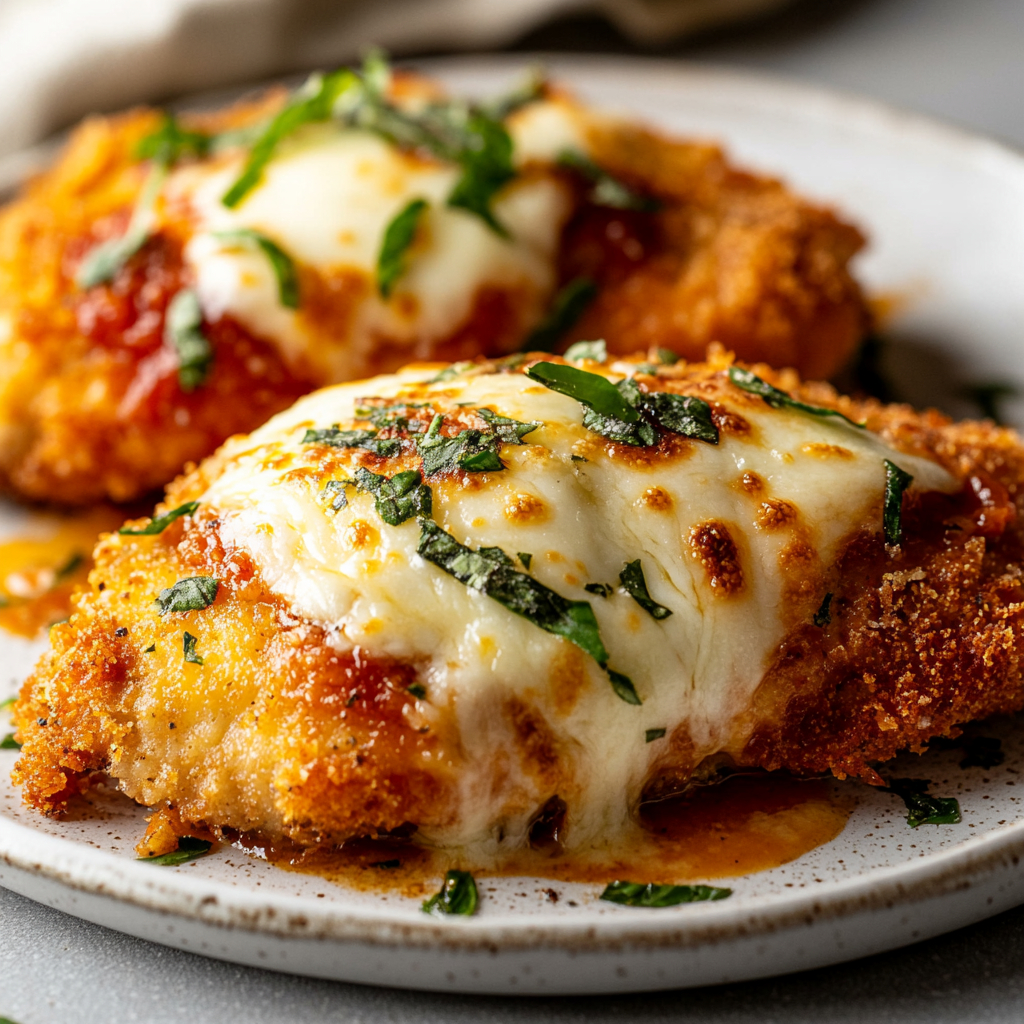
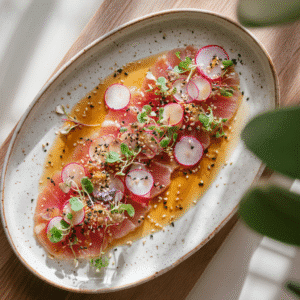
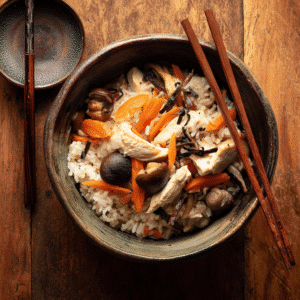
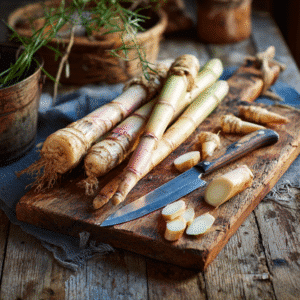
2 thoughts on “Baked Chicken Parmesan: The Ultimate Crispy, Cheesy, and Flavorful Recipe Guide”